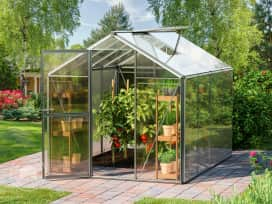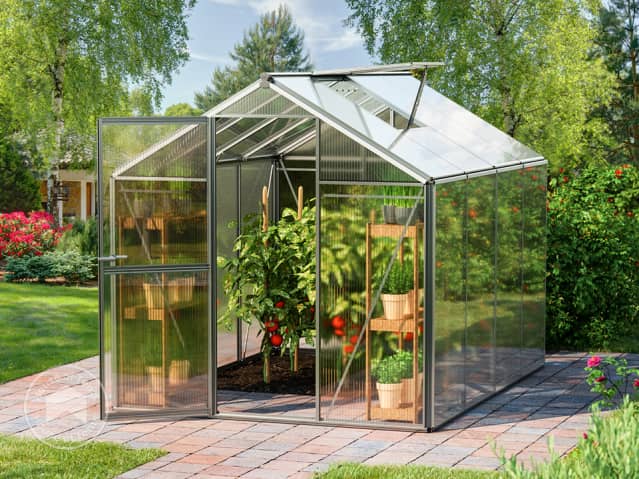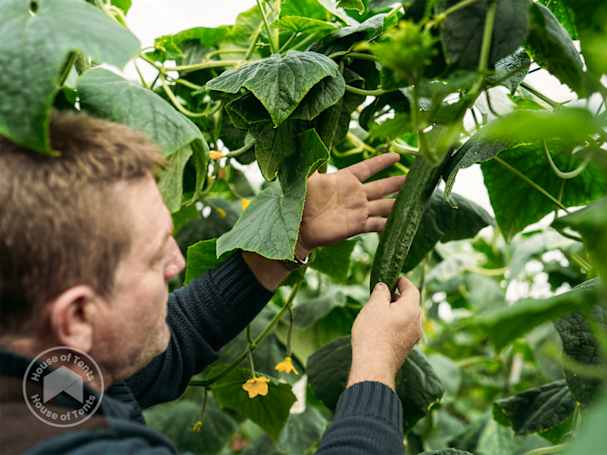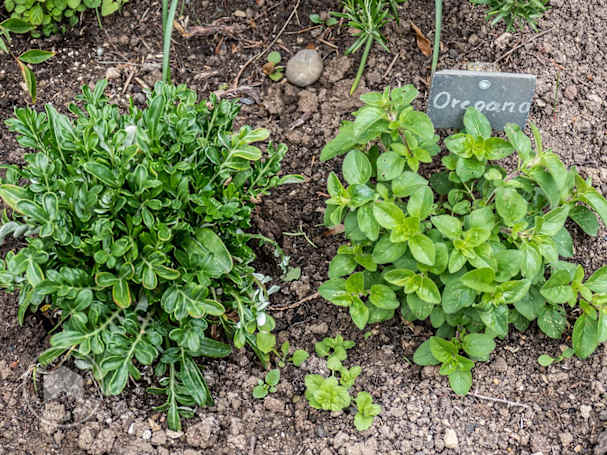
- 6 - 8 mm thick twin-wall sheets
- Sidewall height: 135 cm
- Hinged door
You've just assembled your greenhouse and the most exciting stage can finally begin: growing and harvesting your own fruit and vegetables! Our outdoor greenhouse is ideal for year-round supply. For successful greenhouse gardening, the right layout of your greenhouse plays an important role. Which vegetables and fruit are best? How do you go about it, and when should you start growing?
This guide to growing vegetables and fruit in glasshouses outlines what you need to grow, taking into account soil, air and temperature requirements. Follow our recommendations for successful greenhouse growing and a good harvest.

The first question that arises is what to plant in a greenhouse. With a greenhouse, you can plant a wide variety of fruit and vegetables. We've listed the most commonly grown greenhouse vegetables and what you need to know about them:
Cucumbers like sunshine and warmth. We advise you to choose a spot in the greenhouse where the cucumber plants can get plenty of light, even in winter. On the other hand, you need to make sure that cucumbers in glasshouses are sufficiently shaded in summer, to avoid damaging them. Another requirement is an ambient temperature of around 20 degrees to ensure good growth and a fruitful harvest.
Good ventilation is essential for cucumber seedlings to grow well. The crop can turn yellow if, among other things, the greenhouse is not properly ventilated. Our models are fitted with practical windows and doors that we recommend you open in the morning as well as in the evening, so that the air can circulate.
Cucumbers can be climbers or creepers, meaning they can grow vertically or horizontally. You have two options: planting seedlings in the ground and spacing them out, or planting your seedlings in a gardening pot with a diameter of 60 cm. The ideal time to plant is in May, earlier for seedlings if your greenhouse is heated. The soil should be moist but not waterlogged, and free from sprouts. Finally, water your cucumbers directly at the base and not on the leaves, at least once or twice a week, using water at room temperature.

When sowing greenhouse plants, make sure that you don't plant cucumbers together with tomatoes. Tomatoes don't make for good neighbours for cucumbers. Both plants have different needs: While cucumbers like lots of water, moist air, sun and warmth, tomatoes prefer the opposite conditions: dryness and cool temperatures. So, what does grow well with cucumbers in a greenhouse? Beans, lettuce, fennel, peas, onions, radishes, celery or leeks are good neighbours for cucumbers.
Strawberries may not be the most widely grown fruit, but they are the UK's undsiputed favourite. Growing strawberries in glasshouses is becoming increasingly popular, enabling them to be produced and harvested all year round, even in winter!
Choose your variety of strawberry according to your region and its climatic conditions. As a general rule, strawberries like warmth and don't like humidity. Gardeners should aim to grow strawberry plants in full sun. Place them in a soil structure with high-quality, nutrient-rich soil, preferably moist but not soggy. Remember to space them about 30 cm apart. The ideal time to start planting your strawberries is between July and August, for harvesting the following spring.
We can recommend growing herbs in a greenhouse. The great advantage of the greenhouse compared to gardening with herbs outdoors: the variety of possibilities. You can plant both native, Mediterranean and exotic herbs in a greenhouse. Herbs from faraway countries, which you wouldn't normally be able to grow in your own garden, will flourish in your greenhouse.
In a herb greenhouse, you can sow annual as well as biennial and perennial seeds. Annual seeds include basil, coriander and garden cress, while winter cress is a biennial and herbs such as lavender and chives are perennials.

Peppers are extremely sensitive to the cold and are best grown outdoors in warm regions. Growing your own peppers is possible if conditions are right for this southern vegetable. To grow peppers, you need sun and warmth: the ideal temperature is between 25 and 28 degrees.
Young pepper plants hate the cold! So the best time to sow them is in spring, around mid-May at the earliest. When sowing peppers, we recommend using a soil rich in humus and mixing the soil with compost beforehand. Collect pepper seeds from your kitchen and dry them.
Regular watering is essential for a bountiful harvest! We recommend watering your young plants twice a day. Once your pepper plants start to grow, remember to remove the first fruit to allow the other plants to continue growing. Green peppers begin to colour, becoming red and yellow peppers as they mature.
Another feature of the pepper is that it readily accepts other neighbours in the greenhouse, such as carrots, cabbages, lettuce and tomatoes. On the other hand, don't plant your pepper varieties near potatoes, courgettes or peas. Peppers should be grown well apart, at least 50 cm apart (for mature plants).
It's useful to have an overview of when popular plants should be planted to help you maximize your vegetable crop yields. With the assistance of a reliable greenhouse heater, you can extend your growing season from early spring right into the challenging winter months, ensuring a steady supply of fresh and healthy vegetables throughout the year. This schedule will guide you through the essential tasks and planting timelines to make the most of your heated greenhouse, enabling you to enjoy a bountiful harvest regardless of the weather outside.
Gardeners can grow aubergines, carrots, turnips or lettuces, or other varieties such as spinach and broad beans under glass. A big advantage of garening with a greenhouse is that tender plants like French beans can be planted earlier in the season, without fear of succumbing to frost. Find out about the ideal time to sow and plant your fruit and vegetables. This can vary from one variety to another. To give you an idea, here's a table with a few examples:
| Vegetables/fruit | Sow | Harvest |
|---|---|---|
| Cucumber | May | June |
| Peppers | March | July |
| Chilli peppers | March | July |
| Carrot | February - July | May - October |
| Aubergine | March | July |
| Spinach | March | April |
| Lettuce/Salad | March | April - May |
| Kohlrabi | March | May |
A greenhouse provides the perfect environment for cultivating a variety of cold-hardy crops, including root vegetables like carrots and turnips, which thrive in the protected, frost-free conditions. Additionally, you can enjoy sweet and tender plants like broad beans or sweet peas and compact, nutrient-rich Brussels sprouts, ensuring a diverse and satisfying yield from mid-winter into late winter.
This article suggests a number of a crops that are ideal for growing in a greenhouse for beginners. A great way for beginner gardeners to improve their chances of success is by planting easy-to-grow potted crops. Here are our 4 top tips for gardeners who are just starting out.
Begin with plant varieties that are well-suited for greenhouse growing. Many vegetables and fruits have specific requirements, so opt for those that thrive in the controlled environment of a greenhouse. Some examples include tomatoes, cucumbers, peppers, and strawberries.
Ensure a consistent and optimal temperature inside the greenhouse. Invest in a reliable heating system for winter and a ventilation system to prevent overheating during the summer. Proper insulation and the use of shade cloth can help regulate temperature fluctuations.
Greenhouse plants often require more frequent watering than outdoor crops, as the controlled environment can lead to faster drying of soil. Monitor moisture levels closely and consider automatic watering systems. You can maintain adequate humidity levels by misting or using a humidifier to prevent plant stress and disease.
Greenhouses can be prone to pests and diseases due to the enclosed environment. Implement regular inspections and use organic pest control methods whenever possible to avoid chemical residues on your crops. Isolate new plants for a period to prevent introducing potential pests to your greenhouse.
By following these tips, beginners can create a thriving greenhouse environment for their vegetables and fruits, leading to a successful and rewarding harvest.
Are you planning to grow and harvest your own vegetables in your garden, but haven't found the right greenhouse yet? Or do you have questions about our products? No problem! Our expert customer service is there for you! Feel free to call us or send an email.
Expert advice
